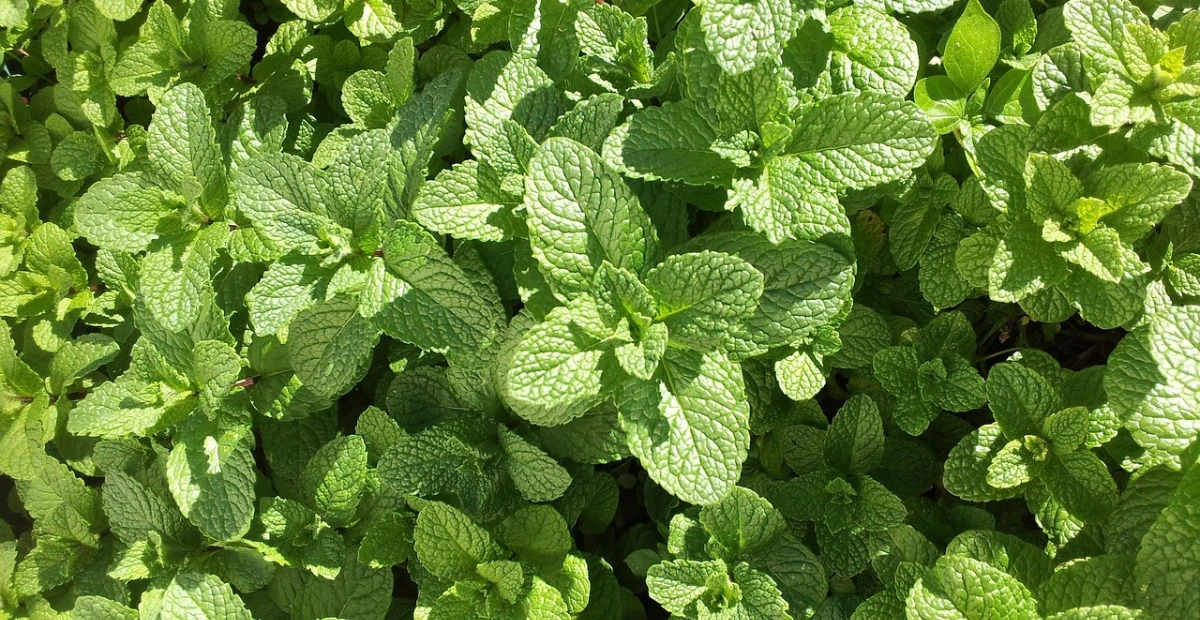Introduction
Imagine stepping outside on a warm afternoon, the sweet, invigorating aroma of fresh ginger and mint filling the air around you. You take a deep breath, feeling instantly refreshed and grounded. Whether it’s brewing a cup of ginger mint tea or adding a few sprigs of this fragrant herb to a dish, there’s something undeniably satisfying about growing your own ginger mint.
advertisement
If you’ve ever considered cultivating ginger mint at home but didn’t know where to start, you’re in the right place. The process of propagating ginger mint may sound intimidating at first, but it’s a simple, enjoyable experience that anyone can do. In fact, with just a few steps, you’ll soon be on your way to growing lush, green ginger mint that thrives in your home or garden. Ready to dive in? Let’s explore how to propagate ginger mint in 9 simple steps.
Table of Contents
What Is Ginger Mint? An Introduction to This Unique Herb
Before you dive into the propagation process, let’s take a moment to understand the plant itself. Ginger mint, a hybrid of ginger and mint, is a fragrant herb known for its zesty and refreshing scent. It combines the cooling properties of mint with the warmth of ginger, making it a versatile addition to teas, salads, desserts, and more.
Originating from Southeast Asia, ginger mint is not just a culinary delight but also offers numerous health benefits. It can help with digestion, alleviate headaches, and soothe an upset stomach. Additionally, its leaves can be used to create aromatic essential oils that have therapeutic properties. Whether you’re using it in the kitchen or for its medicinal qualities, propagating ginger mint at home is a rewarding endeavor.
advertisement
Why Propagate Ginger Mint at Home?
If you’re wondering why you should propagate ginger mint at home, the benefits are plentiful:
- Aromatic Freshness: The sweet, refreshing scent of ginger mint can turn your home into a fragrant oasis.
- Health Benefits: Ginger mint is rich in antioxidants, anti-inflammatory compounds, and essential oils, making it a perfect natural remedy for various ailments.
- Culinary Use: Fresh ginger mint adds a delightful flavor to a variety of dishes—from beverages to soups, smoothies, and even desserts.
- Environmental Impact: Growing your own herbs reduces the carbon footprint associated with store-bought products, and you’ll have access to fresh herbs year-round.
By propagating ginger mint at home, you get to enjoy all these benefits and more, plus the satisfaction of nurturing a plant from scratch.
Tools and Materials Needed for Propagating Ginger Mint
Before you start propagating ginger mint, gather the necessary tools and materials. Having everything ready will make the process easier and more efficient. Here’s a list of what you’ll need:
- Ginger Mint Stem or Root: This will be your starting material. Ideally, you’ll use a healthy, mature stem or root from a well-established plant.
- Potting Mix: Ginger mint thrives in a light, well-draining potting mix. Opt for a mix specifically designed for herbs or one that’s rich in organic matter.
- Pots or Containers: Choose containers that have drainage holes to prevent waterlogging. The size of the pot should allow for root expansion as your ginger mint grows.
- Watering Can or Spray Bottle: You’ll need a watering can or spray bottle to keep your cuttings moist during the propagation process.
- Rooting Hormone (Optional): Although ginger mint can root without it, applying rooting hormone can encourage faster and more robust root development.
- Pruning Shears or Scissors: Clean, sharp scissors or pruning shears are essential for making neat cuts to your ginger mint stem.
- Clear Plastic Bag or Cloche: This helps maintain humidity around the cutting, speeding up the rooting process.
advertisement
9 Simple Steps to Propagate Ginger Mint for Lush Greenery
Now that you have all your materials ready, let’s dive into the step-by-step process of propagating ginger mint.
Step 1: Select a Healthy Ginger Mint Stem or Root
The first step in propagating ginger mint is choosing the right stem or root. Select a healthy, disease-free cutting that has fresh, vibrant green leaves. Look for a stem that’s at least 6 inches long and has visible nodes (the small bumps where new growth will emerge).
If you’re using a root cutting, choose a piece that’s at least 3 inches long and has several buds. Avoid using old or yellowing stems, as these are less likely to root successfully.
Step 2: Prepare the Potting Mix for Planting
Next, you’ll need to prepare your potting mix. Ginger mint thrives in soil that is well-draining yet retains enough moisture to keep the roots hydrated. A mix that’s rich in organic matter will support healthy growth.
If you’re using store-bought potting mix, you can amend it by adding perlite or sand to improve drainage. Alternatively, create your own blend by mixing equal parts of peat moss, perlite, and compost.
Step 3: Trim and Cut the Ginger Mint Stem
Using your pruning shears or scissors, trim the ginger mint stem just below a node. If you’re cutting from a larger plant, make sure to cut at an angle to allow for more surface area to form roots. This will help the cutting root faster and develop a stronger base.
After cutting, remove the leaves from the bottom 2-3 inches of the stem. This will prevent the leaves from rotting when placed in the soil.
advertisement
Step 4: Apply Rooting Hormone (Optional)
While ginger mint can root without the use of rooting hormone, applying it can speed up the process and lead to healthier roots. If you’re using rooting hormone, dip the cut end of the stem into the powder, tapping off any excess. Then, proceed with planting the cutting.
If you prefer a more natural route, you can skip this step. Ginger mint is relatively easy to propagate without hormones.
Step 5: Plant the Ginger Mint Cutting in Potting Mix
Create a small hole in the center of your pot filled with prepared potting mix. Insert the ginger mint cutting into the hole, ensuring that the cut end is buried at least 2 inches deep. Gently press the soil around the stem to secure it in place and remove any air pockets.
Make sure the remaining leaves are above the soil line, as they need light to photosynthesize and grow.
Step 6: Maintain Proper Humidity and Watering Conditions
For the cutting to root successfully, you’ll need to keep the soil consistently moist but not soggy. Water the cutting gently, using a watering can or spray bottle, to avoid disturbing the soil.
Cover the pot with a clear plastic bag or cloche to create a humid environment, which encourages root development. Be sure to leave some air holes or vents for proper airflow, as excessive humidity can lead to mold or mildew.
advertisement
Step 7: Place in a Warm, Bright Location for Growth
Ginger mint cuttings thrive in warm conditions. Place your pot in a location where it will receive bright, indirect sunlight. A windowsill that doesn’t get direct midday sun is ideal, as direct sunlight can cause the cutting to dry out too quickly.
The temperature should be between 65-75°F (18-24°C) for optimal rooting. Avoid placing the cutting in an area with fluctuating temperatures, as this can stress the plant.
Step 8: Monitor Growth and Transplant When Roots Appear
In about 2-3 weeks, your ginger mint cutting should begin to develop roots. To check, gently tug on the stem—if you feel resistance, that means roots are forming. Once you see substantial root growth, it’s time to transplant the cutting into a larger pot or into your garden.
At this stage, you can remove the humidity cover, but be sure to keep the plant well-watered and shaded for the first few days after transplanting.
Step 9: Care for Your Ginger Mint Plant for Lush Greenery
As your ginger mint plant continues to grow, regular care is essential to keep it healthy and lush. Water it consistently, ensuring the soil remains moist but not waterlogged. You can also fertilize it with a balanced, organic fertilizer every few weeks to encourage vigorous growth.
To keep the plant thriving, periodically trim back the stems and remove any dead or yellowing leaves. This will help promote new growth and maintain a bushy, vibrant plant.
advertisement
Tips for Growing Ginger Mint to Its Full Potential
- Pest Control: Ginger mint is generally pest-resistant, but keep an eye out for common garden pests like aphids or spider mites. If you notice any, treat them with an organic pesticide or simply wash them off with a gentle spray of water.
- Companion Plants: Ginger mint grows well alongside other herbs like basil, thyme, and rosemary. Planting them together can help repel pests and create a beautiful herb garden.
- Harvesting: To encourage continuous growth, pinch off leaves as needed for cooking. Avoid cutting the stems back too much, as this can stunt the plant’s growth.
- Avoid Overwatering: While ginger mint enjoys moisture, it doesn’t like to sit in soggy soil. Ensure your pots have proper drainage, and let the top layer of soil dry out before watering again.
Delicious Ginger Mint Recipes to Try at Home
Ginger mint is incredibly versatile and can be used in various recipes. Here are some ideas to get you started:
Table: Ginger Mint Recipe Ingredients
| Recipe Name | Ingredients | Preparation Method |
|---|---|---|
| Ginger Mint Tea | Fresh ginger mint leaves, water, honey | Steep mint leaves and fresh ginger in hot water. Add honey for sweetness. |
| Ginger Mint Smoothie | Fresh ginger mint, banana, spinach, almond milk | Blend all ingredients until smooth. Serve chilled. |
| Ginger Mint Salad | Fresh ginger mint, cucumbers, tomatoes, olive oil | Toss ingredients together with olive oil and lemon juice. |
advertisement
Conclusion: Enjoy Your Ginger Mint Propagation Success
Congratulations on learning how to propagate ginger mint! By following these 9 simple steps, you’ve taken the first step toward growing lush, vibrant ginger mint that you can use for culinary delights, health benefits, and home decor. Remember, propagation is an ongoing process of care, patience, and observation.
Start your propagation journey today and soon enough, you’ll be reaping the rewards of your lush green mint plant. Happy growing!
Frequently Asked Questions (FAQs) About Ginger Mint Propagation
How long does it take to propagate ginger mint?
It typically takes about 2-3 weeks for ginger mint to root and show signs of new growth. However, it may take longer in cooler or less optimal conditions.
Can I propagate ginger mint from seeds?
While ginger mint can be grown from seeds, propagation through cuttings is generally faster and more reliable.
How often should I water my ginger mint cutting?
Keep the soil consistently moist, but avoid overwatering. Water the cutting when the top layer of soil begins to feel dry.
How do I know when my ginger mint has rooted?
You’ll know your ginger mint has rooted when the cutting starts showing resistance when you gently tug on it, and you’ll see small roots emerging from the base.
Can I propagate ginger mint in water?
Yes, ginger mint can be propagated in water. Simply place the cutting in a jar of water, ensuring the base is submerged, and wait for the roots to develop before planting it in soil.
advertisement
Now that you’ve mastered the art of ginger mint propagation, why not share your success with others? If you’ve tried this method, drop a comment below, or share your tips and experiences with the growing community!


